Finding the Best Acoustic Electric Guitar Under $500
Are you looking for the best acoustic electric guitar under 500? Our expert selection includes affordable and reliable workhorse acoustic guitars with built-in electronics.
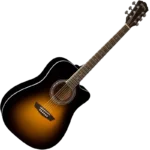
Washburn WA90CE
An affordable acoustic electric guitar with surprisingly good quality hardware, and a nice balanced sound.
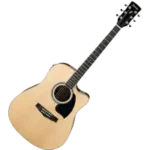
Ibanez PF15ECE
An easy-to-play standard dreadnought cutaway acoustic-electric guitar with Ibanez' brand of craftsmanship.
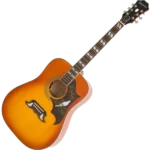
Epiphone Dove Studio
The affordable sibling of the Gibson Dove, complete with the Dove's unique pickguard and bridge designs.
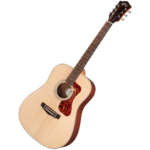
Guild D-240E
A pickup-equipped, solid spruce top acoustic guitar with Guild's vintage style aesthetics and Fishman electronics.

Yamaha FGX800C
Yamaha's student-friendly design is showcased in this stage-ready solid-top acoustic-electric guitar.
We’re reader-supported. When you click product links on our site, we may earn an affiliate commission at no extra cost to you.
The competition in the sub-$500 price range is stiff, with manufacturers regularly releasing new models or updating their current lineup to get an edge. No wonder this price range is brimming with hidden gems!
This guide features top-rated budget acoustic guitars with built-in pickups, showcasing their unique features, playability, and sonic character. I’ll also share practical insights on crucial factors to consider, ensuring you land an instrument that perfectly complements your musical style and aspirations.
The selections are divided into three sub-price groups: sub $200, $200 to $300, and $300 to $500.
Whether you’re a seasoned player seeking an affordable stage companion or a beginner who wants a serious starting instrument, you’ll find a suitable stage-ready acoustic-electric guitar here.
- Table of Contents
The Best Acoustic Electric Guitar Under $200
Washburn WA90CE
Best Budget Pick
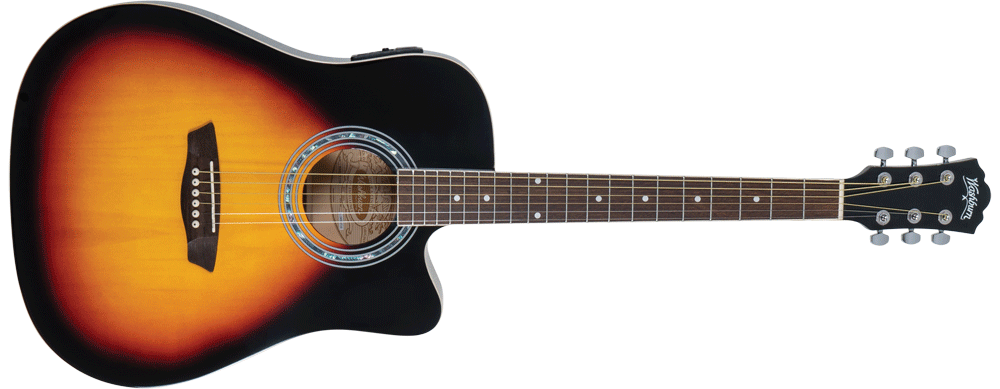
Washburn
Guitarsite Expert Opinion
A budget-friendly acoustic-electric guitar with linden wood, which sounds surprisingly good and balanced for the price. It also has a built-in pickup for easy amplification, making this a good beginner guitar you can play on stage as your playing experience progresses.
Manufacturer: Washburn
Top Wood: Spruce
We’re reader-supported. When you click product links on our site, we may earn an affiliate commission at no extra cost to you.
Washburn Guitars is a long-standing American instrument manufacturer with a rich history dating back to 1883. While not as prestigious as some beloved brands, Washburn offers consistent quality across price ranges and great guitars in the entry- to mid-tier markets.
A case in point is the Washburn WA90CE, a budget-friendly acoustic-electric guitar under $200, making it a good option for beginner and intermediate players seeking an affordable instrument.
To keep the price low, more economical and renewable wood, specifically linden wood, is used. This wood and body configuration produces a balanced tone that works well with pop, folk, and similar styles.
The Okoume neck has a black walnut fingerboard, which is nice to the touch and comfortable to play on.
It has a built-in Barcus Berry LX4 preamp system, which is easy to use and provides a decent amplified tone.
While it may not appeal to those used to solid top response and tone, the WA90CE provides a good entry point for aspiring musicians on a tight budget.
Pros:
- Good build quality and playability for the price.
Cons:
- Won't appeal to experienced musicians
Specifications: | |
|---|---|
Body Shape: Dreadnought Cutaway | Top: Spruce |
Body: Mahogany | Finish: Gloss |
Bridge: Rosewood | Neck: Mahogany |
Fingerboard: Rosewood | Number of Frets: 20 |
Electronics: Isys+ Preamp with Tuner | Pickup Type: Active |
The Best Acoustic Electric Guitar Under $300
Ibanez PF15ECE
Best in Playability
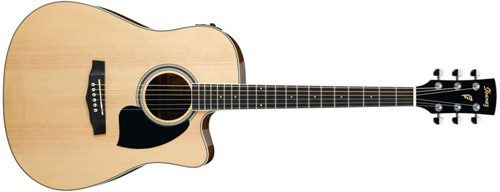
Ibanez PF15ECE
Guitarsite Expert Opinion
This guitar gives you a full-size profile, Ibanez’s fast playability, standard dreadnought shape, and modern built-in electronics – all in a very affordable and eye-catching package.
Manufacturer: Ibanez
Top Wood: Spruce (laminated)
We’re reader-supported. When you click product links on our site, we may earn an affiliate commission at no extra cost to you.
Ibanez has made it possible to own good quality acoustic-electric guitars in the entry-level market, as exemplified by the Ibanez PF15ECE.
This guitar offers a full-size profile, Ibanez’s fast playability, a standard dreadnought shape, and modern built-in electronics—all in a very affordable package. It is also easy on the eyes, with a minimalist design and gloss finish. However, I am not a fan of the gloss finish.
To get the price this low, Ibanez designed the PF15ECE to be as streamlined as possible, starting with a dreadnought body that comprises a laminate spruce top and laminate mahogany back/sides.
The guitar’s X-bracing aids its acoustic projection and structurally and sonically supports the spruce top. Playability-wise, the neck will sport Ibanez’s brand of fast action, with a scale length of 24.96″ and nut width of 1.65″.
The guitar’s cut-away shape lets you reach higher frets better, adding to the instrument’s appeal. Finally, Ibanez equipped the PF15ECE with their AEQ-2T pickup and preamp system with a built-in tuner.
If you want a quality budget workhorse acoustic-electric that’s easy on the pocket and hands, check this out.
Pros:
- Smooth playability, good value
Cons:
- Not a fan of its gloss finish
Specifications: | |
|---|---|
Body Shape: Dreadnought – Cutaway | Top: Spruce (laminated) |
Body: Nyatoh back & sides | Finish: Gloss |
Bridge: Rosewood | Neck: Mahogany |
Fingerboard: Rosewood | Fingerboard Radius: 250 mm |
Number of Frets: 20 | Scale Length: 24.96″ |
Nut Width: 1.654″ | Electronics: Ibanez AEQ-2T preamp with onboard tuner |
D'Angelico Premier Tammany LS
Best Affordable Mahogany Guitar
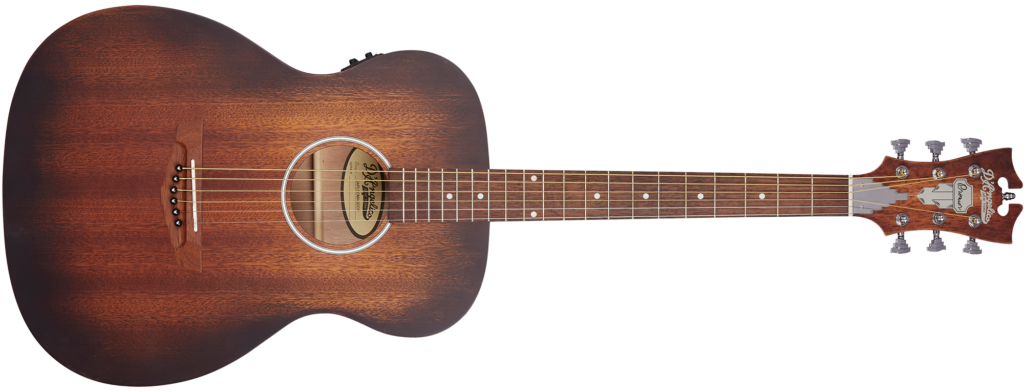
D'Angelico Premier Tammany LS
Guitarsite Expert Opinion
An afffordable all-mahogany body with a warm and balanced tone at an accessible price point. The built-in pickup and preamp system reproduces this warm tonality nicely, making this an impressively good-sounding stage instrument for the price.
Manufacturer: D’Angelico
Top Wood: Mahogany (laminated)
We’re reader-supported. When you click product links on our site, we may earn an affiliate commission at no extra cost to you.
One look at the headstock, and you know that the D’Angelico Premier Tammany LS is not your average acoustic guitar. This also applies to its tonewood configuration, which features an all-laminate mahogany body, significantly departing from the usual spruce + mahogany configurations.
This makes the Tammany LS an attractive option for those who want a warm-sounding practice guitar that can be played on stage.
Get the latest D’Angelico Premier Tammany LS price and reviews at Sweetwater.com
While it would’ve been nice to get a solid-top guitar, high pressure laminate construction has advantages, especially laminate mahogany. The most obvious is cost reduction, but there is also better durability and resistance to humidity and temperature fluctuations.
This guitar has a Fishman Sonitone preamp system with EQ, volume control, and a tuner. Many guitar manufacturers widely use this preamp system, so the amplified sound is what you’d expect.
At its price point, the Tammany LS offers a good balance of features and affordability. Compared to other guitars in this range, it boasts a well-respected brand name and the convenience of onboard electronics.
However, players seeking a more nuanced and resonant sound might prefer to explore guitars with solid wood tops in a higher price bracket.
D’Angelico is an established American guitar manufacturer known for its vintage-inspired aesthetics and focus on playability. While not on par with some high-end brands in terms of prestige, the Tammany LS provides a solid foundation for budding musicians, especially those on a budget.
Its comfortable neck and warm tone make it well-suited for fingerstyle playing, strumming, and singing along. Additionally, the onboard electronics make it a viable instrument for casual performances.
While I would consider it for something more of a sofa guitar than a professional instrument due to its laminate construction, the D’Angelico Premier Tammany LS offers a practical and affordable entry point for aspiring guitarists seeking a playable and well-rounded acoustic-electric instrument.
Pros:
- Distinct warm tone, Stand out appeal, Satin finish
Cons:
- Not for those who want a more nuanced and resonant sound
Specifications: | |
|---|---|
Body Shape: OM-style | Top: Mahogany (laminated) |
Body: Mahogany back & sides | Finish: Satin |
Bridge: Ovangkol | Neck: Mahogany |
Fingerboard: Ovangkol | Fingerboard Radius: 16″ |
Number of Frets: 20 | Scale Length: 25″ |
Nut Width: 1.6875″ | Electronics: D’Angelico Preamp with Tuner |
The Best Acoustic Electric Guitars Under $500
Guild D-240E
Best for Gigging Guitarists
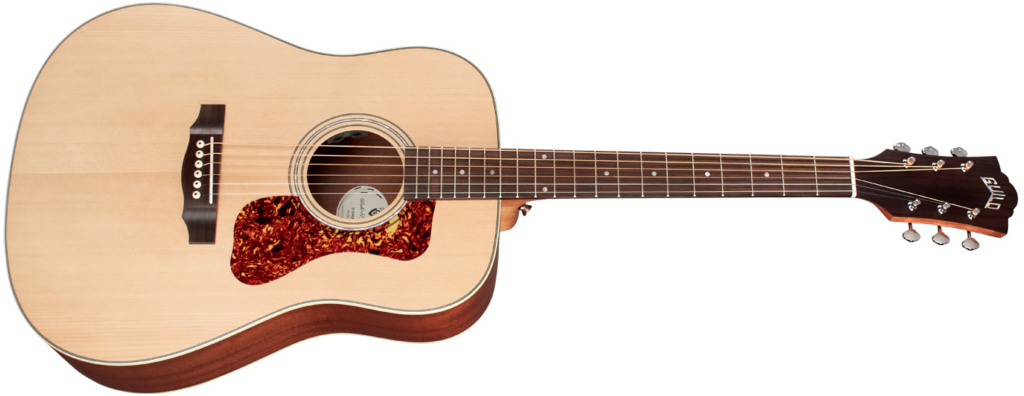
Guild D-240E
Guitarsite Expert Opinion
The D-240E offers a unique blend of vintage aesthetics, solid wood construction, and playable design at an attractive price point. It features a solid sitka spruce top and Guild’s arched-back design. The built-in Fishman-designed electronics allow for stage use.
Manufacturer: Guild
Top Wood: Solid Sitka Spruce
We’re reader-supported. When you click product links on our site, we may earn an affiliate commission at no extra cost to you.
The D-240E draws from Guild’s vintage-style aesthetics, including an arched back. Its solid spruce top blends well with the guitar’s overall shape, resulting in familiar tones and feels at a more accessible price point.
It delivers impressive sound clarity and projection that belly its price tag. Each strum has a nice treble ring, but not overly zingy. It also has good bottom end, without being too boomy. This one has a warmer, rounded tone compared to traditional acoustic guitars like full size dreadnought models.
The comfortable C-shaped neck profile and arched back design, inspired by Guild’s early models, contribute to its smooth playability. Guild is known for quality instruments so you can be sure of consistent production quality.
This makes it an excellent guitar for serious students who want to develop their skills and play on stage. Speaking of stage performances, the Fishman-designed AP-1 pickup lets you easily plug this guitar into an amp or PA system and get good amplified tones.
Whether you’re a fingerstyle player drawn to the warmth and clarity of the spruce top or a strumming enthusiast who appreciates the balanced tone and projection, the Guild D-240E is worth considering.
Its distinct blend of vintage aesthetics, solid top construction, and playable design make the Guild D-240E a solid choice at this price point.
Pros:
- Equipped with a solid spruce top, has a balanced tone, warm yet clear
Cons:
- Not for fans of traditional trebly and boomy acoustic sounds
Specifications: | |
|---|---|
Body Shape: Dreadnought | Top: Solid Sitka Spruce |
Body: Mahogany back & sides | Finish: Satin Polyurethane |
Bridge: Pau Ferro | Neck: Mahogany |
Fingerboard: Pau Ferro | Fingerboard Radius: 16″ |
Number of Frets: 20 | Scale Length: 25.5″ |
Nut Width: 1.688″ | Electronics: Guild/Fishman AP1 with Sonicore pickup |
Yamaha FGX800C
Best for Students
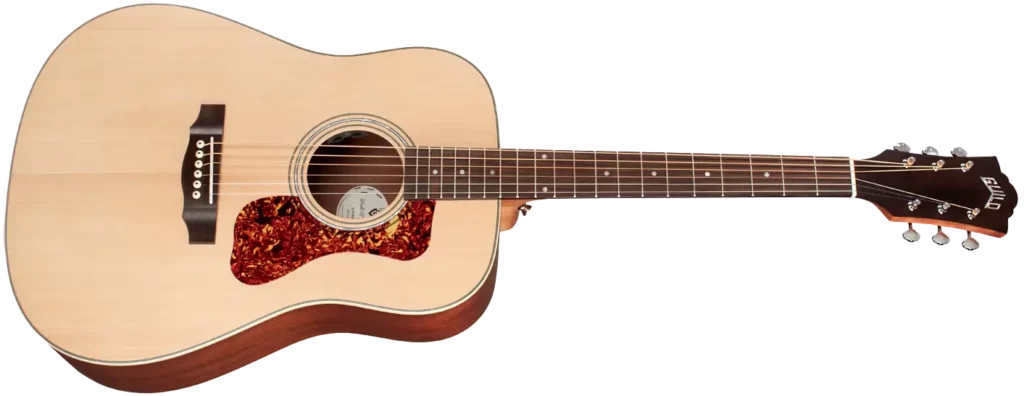
Yamaha FGX800C
Guitarsite Expert Opinion
The FGX800C is a solid-top acoustic-electric guitar under $500 with good projection and student-friendly playability. Build quality is top-notch, as expected from Yamaha, and it comes with a preamp with versatile EQ controls.
Manufacturer: Yamaha
Top Wood: Solid Spruce
We’re reader-supported. When you click product links on our site, we may earn an affiliate commission at no extra cost to you.
Featuring a solid spruce top paired with nato back and sides, the Yamaha FGX800C delivers a responsive and full-bodied acoustic guitar sound that is well-suited for various playing styles.
The solid top construction elevates this option from what other acoustic guitars under 500 offer. Along with its stellar build quality, I couldn’t find anything to complain about.
It has the expected sound of a traditional acoustic when played unplugged, with lots of zing and a boomy bottom end. Its dynamic response and projection are also quite exceptional, and they translate well when played through its preamp.
Yamaha offers many instruments, including classical guitar models, travel guitars, and more. This allows Yamaha to be more self-sufficient. Instead of having third-party electronics, they developed the Yamaha System 66 pickup system, combining an under-saddle piezo pickup with a versatile preamp. It has a 3-band EQ with sweepable mids for tone shaping and notching out unwanted feedback. It also comes with a basic tuner.
It doesn’t offer much visual flair, but this is expected in this price range, and it’s not a guitar that aims to be too flamboyant.
Get the Yamaha FGX800C if you want a traditional workhorse acoustic-electric guitar. With Yamaha’s backing, this instrument will last you a long time.
Pros:
- Solid spruce top, quality construction
Cons:
- Looks a bit bland
Specifications: | |
|---|---|
Body Shape: Dreadnought Cutaway | Top: Solid Spruce |
Body: Nato | Finish: Gloss Natural |
Bridge: Walnut | Neck: Nato |
Neck Profile: Thin | Fingerboard: Walnut |
Fingerboard Radius: 15.75″ | Number of Frets: 20 |
Scale Length: 25.5″ | Nut Width: 1.675″ |
Electronics: Yamaha System 66 (Active – requires 2 x AA batteries) | |
Epiphone Dove Studio
Best for Folk and Rock
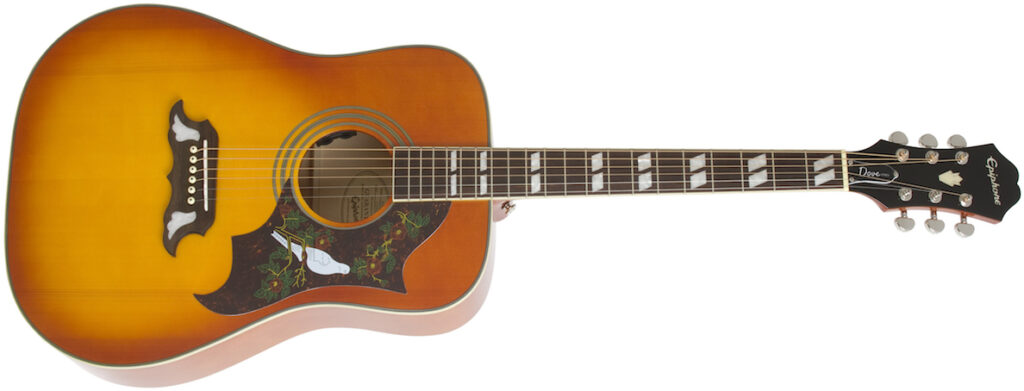
Epiphone Dove Studio
Guitarsite Expert Opinion
The Epiphone Dove Studio gives you a taste of Gibson’s classic Dove design at a more accessible price. It has many of the features of the original Gibson Dove, including the distinct pickguard and bridge designs.
Manufacturer: Epiphone
Top Wood: Solid Spruce
We’re reader-supported. When you click product links on our site, we may earn an affiliate commission at no extra cost to you.
While it doesn’t have all the fancy cosmetics of its pricier Gibson sibling, the Epiphone Dove Studio captures much of the essence of the iconic design at a much more accessible price point.
The guitar features a solid spruce top paired with a laminated maple body, giving it a distinctly bright yet punchy tone. When amplified, the built-in Fishman Sonitone pickups reproduce the guitar’s distinct sound well.
Matching its good tone is its quality craftsmanship. Everything about this guitar feels solid, and careful attention to detail is applied to ensure it encapsulates the aesthetics of the original Dove.
Taking this guitar into the modern era is its SlimTaper D neck profile, which offers a comfortable playing experience for strumming and fingerstyle techniques. This can be a downside for those who prefer a traditional playing feel.
The Gibson Dove has found favor with artists from diverse backgrounds, including John Denver, Elvis Presley, Vince Gill, Johnny Cash, and more. The Epiphone Dove Pro retains this adaptability, making it viable for styles outside folk and country, including pop, rock, and even blues.
This guitar is an easy pick for fans of the original Gibson Dove. But you don’t have to be a fan to appreciate the quality and distinct look of the Epiphone Dove Studio.
Pros:
- Affordable version of the Gibson Dove, Good tone
Cons:
- Can be too flamboyant looking for some
Specifications: | |
|---|---|
Body Shape: Dreadnought | Top: Solid Spruce |
Body: Select Maple back & sides | Finish: Gloss – Violin Burst |
Bridge: Rosewood | Neck: Hard Maple |
Neck Profile: SlimTaper “D” profile | Fingerboard: Rosewood |
Fingerboard Radius: 12″ | Number of Frets: 20 |
Scale Length: 25.5″ | Nut Width: 1.68″ |
Electronics: Fishman Sonicore pickup and Fishman Sonitone sound-hole preamp | |
Hopefully, one of the above guitars is just what you’re looking for, but if you’re still unsure, you might find this article helpful: Expert Advice on Choosing Your First Guitar.
Things to Consider When Buying an Acoustic Electric Guitar
Built-in Pickup
Their built-in electronics, which usually include a pickup and preamp system, set acoustic-electric guitars apart from regular acoustics. Given the value they offer, many consider them the best acoustic guitar option.
Most manufacturers equip their guitars with a piezo pickup in the sub $500 price range because it is cheaper and discretely installed under the saddle. The piezo pickup is usually paired with a built-in active preamp that provides volume control and tone shaping via EQ. Some even come bundled with a tuner that can be accessed directly on the preamp interface.
While the piezo pickup system works well for live performance, some are unsatisfied with its bright tone and quirky dynamic response. Some prefer magnetic pickups because of their balanced sound, but they tend to sound more like an electric guitar than an acoustic one. More premium guitar models come with microphonic or transducer pickups, which capture the guitar’s sound like a mic. This is the most natural sounding but is prone to feedback and background noise.
Some of the best acoustic guitars go the extra mile and equip their acoustic-electric guitars with multiple pickup types to cover all the bases. Still, these instruments are usually priced much higher. Thankfully, there are now several aftermarket pickups that you can choose from in case you want to expand your guitar’s pickup options.
Acoustic Guitar Body Profile
The shape and size of an acoustic guitar’s body greatly affect the resulting sound quality and projection, so it should be a top consideration. The full size acoustic guitar “dreadnought” is the most popular acoustic guitar shape, but there are many variants to choose from.
Naming all the various shape variants is tricky, because brands tend to use different names. You’ll see differences of naming conventions between Martin Guitars, Taylor guitars, Gibson Guitars, etc. The key is to remember that bigger-bodied acoustics tend to have more projection and emphasis on the bass response, resulting in a fuller sound. Smaller and thinner ones, like parlour guitars, produce more upper middle frequencies, producing a clearer and brighter sound.
But it’s not just about tone because your playing comfort is directly affected by the body size and shape. It’s best to get one that lets you play comfortably. A small bodied guitar is ideal for younger students, but it can be awkward for those who are used to big bodied acoustic models.
Also, most acoustic-electric guitar models have single-cutaway body designs that allow easier access to upper frets, but some stick to traditional aesthetics.
Tonewood
In addition to their aesthetic and structural support role, the wood used on an acoustic guitar dictates much of its resulting sound. For this reason, you ought to look at this specification closely. Steel-string acoustic guitars with solid tops are preferred in the acoustic guitar world because of their increased response and projection. Still, they are usually priced higher because of the extra cost the material requires.
On the other hand, those with laminate tops are budget-friendly because they are more affordable and more resilient to temperature and humidity changes. If you’re looking for an acoustic-electric guitar with a solid back and sides, you’ll have to stretch your budget above the $500 range.
Spruce and its many variants are commonly used on acoustic guitar tops for their bright tonality. But others prefer the warmer sound of cedar and mahogany; they also complement the more common spruce acoustic sound nicely when playing in a guitar ensemble.
Neck tonewood is not a big deal, but some people are picky and prefer their new guitar to have a specific tonewood, like a maple neck or mahogany neck, mahogany fretboard or ebony fretboard, and more.
Playability (Neck specifications)
If you want an enjoyable instrument, you must pay closer attention to neck specifications. For smaller hands, you want a guitar with a narrower nut width, while those with bigger hands ought to get wider ones, like those of classical guitars.
Scale length dictates the length of the string on the guitar, from the nut to the bridge saddle. The shorter scale length found on a parlor guitars and other smaller acoustics mean less string tension, which is easier to play at the cost of some loss in tone.
On the flip side, longer scale lengths have increased string tension, which is generally harder to play but better sounding.
You also need to check the string action or the height that separates the strings from the fretboard. Too high an action can be a pain to play, while too low will result in the dreaded fret buzz sound.
Budget Acoustic Guitars and Aesthetics
Last but not least is aesthetics. You want a guitar that looks good to you, even better if it inspires you to practice and play. This is where color and finish come into play. Some of the guitars listed here have decorated pickguards and bodies, while others have a more streamlined look.
If you need to get an amplifier for your acoustic-electric guitar then check out the Gearank Guide to The Best Acoustic Guitar Amplifiers.
Jason Horton
Lead Author
Alexander Briones
Contributor: Research and Supplemental Writing


5 thoughts on “The Best Acoustic Electric Guitar under 500”
if you just eliminate the “it depends” answer. what guitar has solid top, great electronics and a nice warm acoustic sound?
or closest approximate in the $6-800 range?
do any Martin’s come with electronics?
although these have a great unique sound the body tends to get in the way.
That is not a picture of the epiphone aj-220sce.
Actually, it is.
The Epiphone AJ-220SCE comes in 3 finishes: Natural, Vintage Sunburst (pictured) and Ebony.
Does anyone have any information on Carlo Robelli electric accoustic guitars, model cfmc10mrd? I’m looking for cost,reviews,and years of production
Love this list. However, why not consider Breedlove, Fender or Ibanez? They also have some good options at this price range, right?
How about a follow up post with few more options?
Thank you!